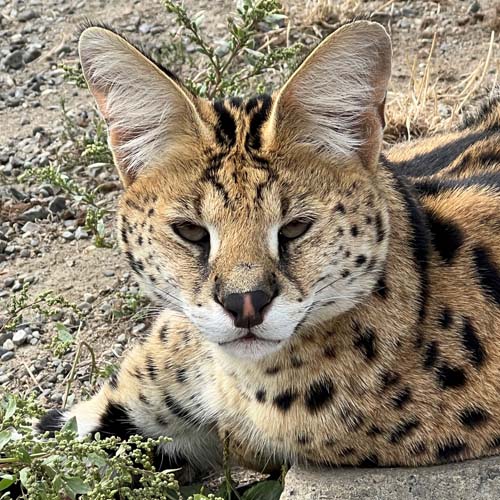Servals and their domestic hybrid cousins, the Savannah Cat, are still commonly owned in the United States. As kittens they are similar to domestic cats in size and behavior, but as they mature the wild and highly active nature develops. These cats can leap straight up to most household ceilings putting items at all levels accessible. They naturally stun and kill their prey by violently striking and stunning it with their front paws. Servals do not like to be cuddled and have razor sharp teeth. Their exceptional hearing leads them to startle and spook at loud or unexpected noises. Currently Servals and hybrid domestic cats like Savannah Cats are one of the most requested rehome / rescue cats once they have outgrown “cute” and reach maturity.
Serval – Leptailurus serval
Habitat: Africa, mainly grasslands, marshy areas, and riverine
Lifespan: Wild 10-20 years; Captivity 15-20 years
Diet: Carnivore
Status: Least concern
A medium-sized, slender, spotted cat with long legs and neck, small head, short tail, and large, rounded ears. It has the longest legs of all cats. Body color and pattern variable, yellowish-fawn, with distinct scattered black spots and bars, extending down legs. Under parts paler, usually also spotted. Small white muzzle, golden-yellow face, with small black spots on cheeks, nose black, occasionally with a pink mark. Brown or greenish eyes, rimmed with black. White whiskers. Very large, rounded ears, each with 2 black bands separated by white patch at back. Short black banded and black tipped tail, only reaching to the hocks of the hind legs.
Servals are usually solitary but also in pairs. Usually nocturnal, but also active in early morning and late afternoon. Prey is located by sight or hearing (large ears to locate burrowing rodents underground and dig them up) and caught with a slap of one forepaw, or a high arching pounce. Playing with prey seems to be common. Servals regularly wade in shallow water in pursuit of prey. When foraging tend to follow regularly used pathways and roads.
Servals live in habitats with water, adjacent tall grassland, reed beds or rank vegetation fringing forest. Also, areas where sugarcane is grown, because of abundance of rodents. Mainly in higher rainfall areas from sea-level to higher grassed slopes of mountain ranges.
The cat pounce – having located prey, usually at dusk, and mainly by hearing, the serval excels at the cat pounce. It leaps up to 13 feet (4 m) horizontally and more than 31/4 feet (1 m) high, to strike the victim with its forepaws. This cat eats rats and similar sized rodents, birds, fish, and large insects such as locusts. Frogs are a favorite of wetland-dwelling servals.
The average litter of 2 young is born after 68-79 days’ gestation. Young are born in burrows dug by other species, among long dense grass, or under bushes. They disperse at about 1 year.
Meet Our Servals

Ozzy – aka “The Boss”
Ozzy, a young African Serval, arrived in December 2020 and has already won the hearts of our crew. Ozzy’s family loves him very much, but due to regulations regarding ownership of Serval cats they knew it was better to place him with us than to risk having him taken and euthanized due to restrictions on owning a Serval. We appreciate their putting Ozzy’s future and best interests ahead of their love of having him with their family and entrusting him to Cat Tales for his forever home. We wish to thank them also for their generous donation to our year end fundraiser, which helped to fund setting Ozzy up in his new forever home. Born April 7, 2019


